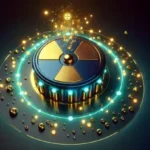The first detection of quantum entanglement between pairs of quarks
Quantum entanglement is an interesting idea in quantum mechanics, which is the science of very small particles. It explains how particles can connect in ways that don’t follow normal physics rules. When two particles, such as a top quark and its opposite (called an antiquark), are entangled, they affect each other. If one particle changes, the other one responds instantly, even if they are far away from each other. This phenomenon challenges our everyday understanding of how objects interact and has deep implications for quantum mechanics.
The Significance of Top Quarks in Particle Physics
The top quark is the heaviest known fundamental particle. It plays a key part in understanding quantum mechanics. This is especially important when studying how tiny particles behave at very high energies. One example of this is when scientists smash particles together at the Large Hadron Collider (LHC). The LHC is a huge machine at CERN, a research center. Scientists use it to study what happens in these powerful collisions. Recently, researchers at the LHC aimed to measure entanglement in top quark pairs produced during proton-proton collisions. Such experiments could shed light on fundamental physics aspects and advance our understanding of the universe.
Measurement of Quantum Entanglement
The study of entanglement requires sophisticated measurements. In 2016, researchers at the Large Hadron Collider (LHC) ran some experiments. They focused on specific events. These events produced two leptons with opposite charges. Leptons are particles, like electrons, that do not interact with the strong force. The researchers chose to study these instead of looking at many different types of particles.
Top quark pairs
The results were remarkable! The observed values suggested a strong indication of entanglement within these top quark pairs. A confidence level higher than five standard deviations proved this phenomenon. This means scientists were very sure about their results. It also showed that quantum mechanics works, even in extreme conditions. These conditions happen during experiments in high-energy physics. In these experiments, particles move at extremely fast speeds. They also carry a huge amount of energy.
The Nature of Quantum States and Bell Pairs
One way to describe entangled particles is through their relationship to quantum bits, or qubits. For example, if we consider a specific type of entangled state known as a Bell state, it behaves uniquely compared to non-entangled states. In a Bell state like |ψ−⟩ = (|01⟩ − |10⟩)/√2, measuring one qubit instantly reveals information about its partner, even if they are separated by large distances.
Rationale behind measurement
This behavior illustrates why measuring such states is crucial for fundamental physics research. By studying experimentally observed Bell states among top quarks at the LHC, scientists can explore quantum correlations further and uncover deeper insights into how nature operates on microscopic scales.
Towards Future Discoveries Beyond Standard Model Physics
The goals aren’t just limited to understanding current physics principles; they also encompass potential discoveries beyond what we know as the Standard Model (SM). Many theories suggest that phenomena unaccounted for within SM predictions could emerge when examining quantum behaviors more closely at energy scales offered by colliders like the LHC. These interactions may open pathways toward unveiling new theories or extensions that reconcile gravity with quantum mechanics.
Closing Remarks
Exploring magnetic forces that hold particles together or shed light on still-mysterious interactions would significantly transform our understanding of fundamental laws governing matter and forces around us!
If you wish to delve deeper into quantum entanglement studies involving quarks and unravel exciting advancements underway within this field—the original paper detailing these remarkable findings is available for more extensive insights: ArXiv: Quantum Entanglement in Top Quarks.
You can also discover more articles related to STEM topics at ENTECH by visiting our website: entechonline.com.






